Image #1… High Speed Sync and HyperSync.
Question… Hi Dave, I found your WATR articles on High Speed Sync with Speedlights fascinating. Recently, I have heard about using “HyperSync” with Elinchrom Rangers and the Pocket Wizard FLEX TT5 system. Can you explain the how to use HyperSync, the difference between it and HSS and why we might use one over the other? Many thanks. John
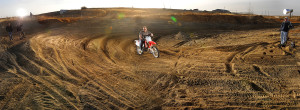 Answer… Hi John. Thanks for a great question. Many folks have asked similar questions about High Speed Sync with Speedlights and using the new Pocket Wizard FLEX TT5 with HyperSync with larger strobe systems. Well, I could write a book on this subject, but an efficient answer is this: Each flash or Speedlight has a “flash duration” or length of time that the flash heats up, “peaks” its power, and cools down. A shutter speed of 1/250 tends to cover this entire time spread making use of all the flash output, especially the ‘peak” of the power graph. If I use 1/1000 the shorter/faster shutter time makes use of a smaller portion of the “flash.” Dedicated Speedlights to the camera make sure that the shutter opening occurs at the “peak” of the flash. With an undedicated system a fast shutter speed above 1/250 can be “off centered” and not make use of all the flash power output, or miss the peak power of the flash entirely. The Pocket Wizard FLEX TT5 system helps you align the shutter opening to occur at the “peak” or brightest moment of the flash, but requires you to program-in your camera’s shutter to coincide with the “peak” power point via your own computer. Sounds scary, but its not really that complicated. Nikon Speedlights are dedicated to Nikon camera’s (and Canon Speedlites are dedicated to Canon camera’s) and are already perfectly aligned at the peak point internally within the camera. Nikon Speedlights and Canon Speedlites, while being perfectly centered in the “peak” look as though they are loosing power as you go from 1/500 to 1/1000 to 1/2000 or faster. That is because the shutter opening is getting small/shorter/faster and is not spanning the entire distance of peak flash duration. I’m saying all this in rather plain language John. I don’t know what prior flash sync knowledge you have, but in general this is what is happening. I had the opportunity to make this image using the NEW Pocket Wizard FLEX TT5 system with HyperSync settings for Pocket Wizard’s Advertising campaign late last summer. These Motocross riders were racing by at about 30-40mph and the FLEX
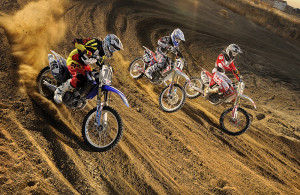 TT5 system on my 2 Elinchrom Ranger RX 1100 ws AS packs with “A” strobe heads allowed me to use a shutter sync speed of 1/1250 instead of a standard sync speed of 1/250. This is a big break through in strobe lighting technology because we can combine strobe with available ambient light…indoors or outdoors using fast shutter sync speeds…a.k.a. “HyperSync” or “High Speed Sync”. When I need BIG strobe power to cover a BIG area in bright sunshine conditions I will use the FLEX TT5 system with HyperSync. I will use Speedlights if the area is smaller and I can position my Speedlights closer to the action subject. Nikon D3s, ISO400, 1/1250 at f10, Nikon 24-70mm lens, WB 6700K, 2 Elinchrom Ranger RX 1100 ws AS packs with “A” strobe heads, Pocket Wizard wireless FLEX TT5 on the hot shoe of my camera, AC3 fits on top of the FLEX TT5 and controls all power output to each Ranger, 2 ST4 units connect to the Ranger via the Elinchrom EL 19347 Skyport post, 2 Reflectors, 2 Manfroto lightstands, SanDisk 32G Extreme Pro Flash Card. This picture (1A) illustrates the area of the course for our picture and how far away my strobes were placed. This strobe to subject distance would be too far for Speedlights to reach during bright sunshine hours. The much more powerful Ranger RX with 1100 ws of power easily carried the distance and overpowered the bright sunshine for a stylized Motocross image (1B). Thanks for a great question John. Adios. Dave
|
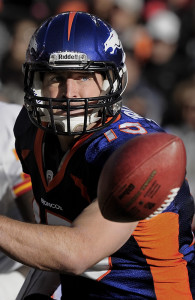 Image #2…Image Count per NFL Game. Image #2…Image Count per NFL Game.
Question… Hi Dave, I just found your website and have to say I was quite impressed with the photos you have posted. I have been doing high school sports for a long time and the past two years had the opportunity to shot for one of the NCAA Division II football teams here in Colorado. At the beginning I found I was taking nearly 700 photos per game. I have toned it down to about 400 photos per game. With an average of about 130 total plays in a football game, how many total photos would you or your colleagues take in a typical football game? This is strictly the game and not any of the pre-game, halftime or post game festivities. With that number of photos, what percentages of photos do find as keepers in the post production and actually run through the workflow? Thanks, Sean from Colorado
Answer… Hi Sean. Thanks for submitting a very interesting question. Only a few have asked this one before. My last NFL game this season was in Denver and gave me a total of 826 game action images. This does not include 200 or so images of pre-game, post-game, fans, ambiance, etc. Of those 826 game action images I have a folder of SELECTS containing 150. This doesn’t mean that I have 676 wasted action images. Many of them are good ones, but not relevant to the news of that game, or playoff key player image potential. Mostly I was following the game action, but in particular Tim Tebow. Of the 150 SELECTS I pulled 50 jpgs for a SELECTS II folder and for my client to view. I added a slight increase of contrast and saturation in my camera Picture Control menu, but felt a slight increase in contrast was needed in PhotoShop as well. The client chooses from that top 50. I always shoot both jpg and RAW at the same time as is my custom and the norm for many magazines like Sports Illustrated, ESPN, Newsweek etc. The dual card slot on the Nikon D3s is set to the Over Flow setting rather than jpg on one card / RAW on the other card. From that top 50 I pulled 20 SUPER SELECTS that the RAW file will be brought into Nikon Capture NX II for any toning that is necessary. That being said, little or no post processing was necessary with only a few images receiving a slight increase in contrast. Each image was saved as a TIF file. Sean, this is my typical procedure following each game. I do very little post processing to my images. Rather, I use the Standard setting in the camera Picture Control menu and just increase the contrast and saturation a couple of “clicks” in that same menu. My total number of action images may vary depending on how much great or relevant action there was during the game, but in general this is typical. If you look at the total number of images 1,026 of both action and pre-post game imagery and divide by 36 (a roll of film) it comes out to the equivalent of shooting 28 rolls of film. This is about the same number of rolls/images that I shot on slide transparency film before I began shooting digital in the 1999-2000 NFL season. A great game, especially a playoff game for me would require between 22-28 rolls of 36 exposure film back then. With great pleasure, here is one of the hottest sports stories of the 2011-2012 NFL season, Tim Tebow. Nikon D3s, ISO1250, 1/1600 at f10, WB 6250 K, Nikon 400mm f2.8 with TC-14E 1.4x Teleconverter, Gitzo Carbon Fiber Monopod, SanDisk 32G Extreme Pro Flash Card. Usually sports photographers use shallow depth of field aperture settings like f2.8, f4.0, or f5.6 in hopes of dissolving the background and isolating the player.
Bonus Answer: So you might wonder why I used such a high aperture setting of f10 for this play? … It was my hope that Tebow would run the option and pitch the ball to Willis McGahee, and if so I wanted the ball to be clear rather than too soft at f4.0. Tim did pitch out, and the ball is much clearer at f10 than it would have been at f4.0. Great question Sean thanks for asking it. |
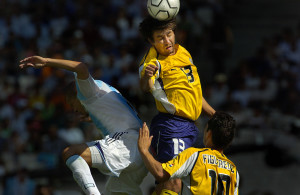
Image #3…9 fps Burst and Auto Focus Settings
Question…Hey Dave, I’m a big fan of yours and how tightly you shoot sports. I am curious though as to your sharpness rate on sports assignments that you don’t add light to. Example being the Tim Tebow shot in the last WATR article. Was that shot one out of 9 that were in focus? Or did you have 9 in focus in your sequence? Marc
Answer… Hi Marc. Thanks for you’re kind words and a great question, one that is asked often. I rarely make a practice of shooting bursts of 6,7,8, or 9 frames/second (fps) when shooting sports action. Usually I make a bust of 2-3 and always look for the peak moment of action, which might only require 1 frame. That was the case with the image of Tim Tebow from February WATR…1 shot. I shoot both RAW and jpg at the same time for all my clients. If I shot 9 fps with every play I would, 1. Have way too many images to edit through, and 2. I might fill the buffer and have no frames left for the rest of the play…which could be a fumble that can really eat up some fps. You don’t want to leave your camera empty, not even for a moment, because that might be “the moment” of the game. The first question I answered in the February WATR gives my Camera and Custom Menu Settings. Check out the Auto Focus Custom Settings I use as I stated in the February 2012 WATR article….
My Auto Focus setting is “C” continuous (located on the front of the camera body) because I want the lens to always be follow focusing on my subject. I do not use Single Servo…if I want to hold the focus on my subject and then recompose the scene I simply press the AF Lock button on the back of the camera. With my camera’s Auto Focus setting in “C” continuos the Priority Selection is in the Release mode, which allows the camera to shoot a picture even if the “In-Focus” indicator is not illuminated. Sometimes when following the game action the AF point or group might not be placed on the moving subject long enough to where the “In-Focus” indicator is illuminated, but the subject is actually in focus. Therefore, I want the camera to make a picture whenever I press the shutter. If I were to set Priority Selection in the Focus mode the shutter would not release unless the ‘In-Focus” indicator is illuminated. This can drastically slow down the continuos frames per second shooting rate (from 9 fps to as low as 2 fps) because the “in-Focus” indicator has not had time to illuminate during the burst of multiple fps. Both the shutter and back button will activate the auto focus capability.
Also keep in mind that, as you made mention of, I do like to shoot tight and tend to fill the frame with my athletes. Neither this image of Tebow, nor the image of Tim from last month is cropped, which means the auto focus sensor has no problem locking on him. If your subject is small in the frame, maybe only half the frame size, it is sometimes difficult to keep the auto focus sensor on your action subject. The 3D Tracking can be a help, but the photographer must still be precise with placement. My suggestion is to wait for the action to fill your frame and try shooting 2-4 fps burst instead of the “shot gun” 9fps approach to capturing the action. This image from the gold medal Olympic final between Argentina and Paraguay illustrates shooting the peak moment of action with a Nikon 600mmf4 and 1.4x teleconverter (840mm focal length). I shot 2 frames of this header…here is frame #1. Frame #2 did not have the ball and the moment was over. Nikon D2h, ISO400, 1/1250 at f5.6, Nikon 600mm f4.0 lens with Nikon 1.4x Teleconverter, WB 6700K, Gitzo Carbon Fiber Monopod. This was a very good question Marc and I hope this answer helps you get a higher percentage of in-focus images. Adios. Dave
|
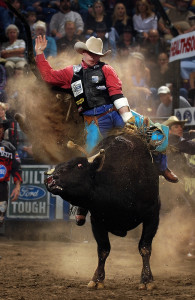
Image #4…Advice for Photographing indoor or Night Rodeo
Question…Hi Dave – the new website is great – good job! Dave how about you’re best advice for shooting rodeo. Night rodeos are (generally) poorly lit and can be dusty – flashes catch dust particles and create a haze. ISO is WAY up – 6400 f/stop wide-open (2.8). Gotta magic bullet for this, hmmm? Thanks for your input. Terry, Lazy R
Answer… Howdy Terry. Perhaps a NEW Nikon D4 with its clean ultra High ISO is on your wish list. That’s a short answer, but maybe a good solution if this is your livelihood. Rodeo is darn tough indeed, especially indoors or at night. I use sport strobes for any of the indoor rodeos I ever cover. I do not mind the back-lit dust and actually think it looks great as it was part of the event action. Fast lenses are another solution. Nikon makes a 200mm f2.0. You might also consider using multiple Speedlights in High Speed Sync mode. I have used 4 of them in the catwalks above competition areas with very good results. You could also use larger strobes and trigger them with new FLEX TT5 system by Pocket Wizard. Both these lighting set-ups make use of High Speed Sync (Speedlights) or HyperSync (FLEX TT5) and combine it with the available ambient of the arena lights. You could easily knock down your ISO to ISO3200 or less, have a strobe-lit quality, but not illuminate the dust so much. A Nikon 200mm f2.0 lens runs about $5,100. If you don’t want to go with Speedlights or sport strobes, the Nikon D4 is probably the best answer, as you would use the camera for everything else you photograph. The 200mm f2.0 lens, Speedlights or Strobe systems are likely to be more special only to extreme low light situations. I have enjoyed photographing rodeos and the PBR over the years. This image of Bull Riding captures plenty of “strobe lit” dust, and for me, looks interesting and lends itself well to the overall excitement of the sport. Nikon D1x, ISO400, 1/500 at f7.1 (no HyperSync in years past but the old Nikon D1X had a 1/500 flash sync shutter speed), Nikon 70-200mm zoom lens, Elinchrom 1000R Sport Strobes (now only available in Europe, but ask your Manfrotto dealer about the 600RX or Ranger 1100 ws strobe systems), Pocket Wizard Multi MAX Transceivers, SanDisk Flash Card. Photographing indoor sports action has its challenges, but these answers are solutions. Money required of course, but solutions. All the best Terry. Adios my friend. Dave |







